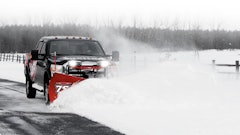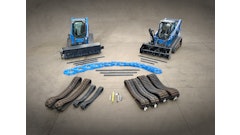
For a snow removal contractor, selecting the right plow for a job is one thing. However, as part of that process It is important to consider the cutting edge on your snowplow blade that will be scraping up the snow, ice, and slush on each pass.
The cutting edge provides an extra layer of protection to the bottom of the plow blade. When worn down, it can easily be replaced, rather than wearing down the actual plow itself.
There are number of factors to consider and understand related to the cutting edge of your plow.
Nate Kallay, Winter Equipment director of marketing, says questions to ask include whether you want the edge to plow, cut, scrape, or conform to the road? And are you worried about damaging the road?
Additional considerations include the type of work that will be done with the plow and the type of surface it is being utilized on.
“If the plow will regularly be used in retail applications with decorative concrete, cobble, or sensitive surfaces, the most important factor is ensuring the surface isn’t damaged,” says Seth Bergerud, product manager parts and accessories for Douglas Dynamics.
Selecting a polyurethane or rubber edge is often the best choice for sensitive surfaces, although they tend to wear more quickly than steel.
Conversely, he says road plowing, long runs, or very hard surfaces like granite on mountain roads may wear the standard steel edge more quickly and may require harder material like carbide reinforced edges. “Understanding the application and the work that will be done is critical in equipping your plow with the proper cutting edge,” Bergerud says.
In addition, any pre- or post-application of deicing materials can be a factor.
“Deicing materials, whether applied before or after a storm, can significantly aid in cleanup and may reduce cutting edge wear by decreasing plowing time,” says Ty Steinbrecher, technical service manager BOSS Snowplow.
Signs you need a new edge
“This can result in residual snow left behind and rework or require more salt to melt what was missed,” he says, adding that either way, it ends up costing you more money.
Cutting edges that are scraping against the ground push snow and ice do get worn down.
“Replacement is necessary when the edge reaches the end of its useable life,” Steinbrecher says. “A few indicators that an edge is ready for replacement are reduced scraping performance, the bottom of the cutting edge wearing near the base of the plow moldboard, and on BOSS urethane edges, when the BOSS logo is no longer visible.”
There are many ways to gauge the need to change a cutting edge. Kallay says traditionally, the “two-fingers” method is used, meaning that if your blade has less than “two fingers” to the moldboard, it is time to change the blade.
Premium cutting edges like those from Winter Equipment, Western Products, and BOSS Snowplow cutting edges feature wear-indicators that visually show when the service life of the cutting edge has expired, and it is time to replace it.
“If you let the cutting edge wear down too low, it can damage the actual plow and make for an expensive replacement of the entire unit,” Bergerud says. “The cutting edge should be replaced before the plow frame is exposed or the moldboard experiences rubbing.”
He says cutting edges wear should be monitored regularly throughout the season.
Bergerud says there are several clear signs your cutting edge should be replaced.
First, uneven wear of the edge in contact with the surface. Several factors can lead to uneven cutting edge wear. Bergerud says it is often the result of three factors: plow set-up, plow maintenance, or repeated use on uneven surfaces.
“Most commonly, a cutting edge wears unevenly because the plow is running over an uneven road surface,” Kallay says. “The angle of the blade will cause excessive wear on the toe (the leading edge) of the blade. Windrowing will cause your leading edge to wear at a more aggressive rate than your trailing edge, as well.”
Another example of this is curbside plowing. Bergerud says if the plow is regularly used for long runs against curbs that are uneven to the road surface or have a curved surface, the cutting edge will wear and conform to those surfaces. When the plow is then used in other settings, the uneven tips will leave snow trails or no longer be able to scrape cleanly.
Steinbrecher says overall vehicle setup can also lead to uneven wear.
“This includes incorrect push beam heights, worn suspension components, and uneven tire pressure,” he says, urging contractors to consult their owner’s manual for proper vehicle setup, including recommended push beam heights.”
Bergerud agrees, noting that proper plow installation is important to ensure proper operation because this is when the height of the plow frame is set relative to the surface and vehicle.
“If the height is not properly set at install, the nose-up or nose-down angle will cause the outermost edges of a straight blade or the center edges and outer wing edges of the blade to wear prematurely,” he says. “At angle, the blade is not parallel to the ground, and more pressure is placed on these outer points, causing an increased rate of wear.”
Even when installed properly, the plows must be maintained. Insufficient plow maintenance can be a driver of uneven wear.
Bergerud says plows with blade oscillation need to be greased regularly. “If the plow blade is unable to roll and adjust to uneven surfaces freely, the cutting edge will wear unevenly and prematurely at the outermost edges,” he says.
Curb guards and shoe kits can extend the cutting edge’s life and are available as accessories for most plows through most snow removal dealerships.
Additionally, Steinbrecher says damaged components, like bent push frames on the plow, can cause the edge to sit lower on one side or the other.
“Striking hidden obstacles can damage the edge, causing bending, cracking, and poor scrape performance,” Bergerud says. “The cutting edge also adds rigidity to the blade of the snowplow, and once it is yielded can weaken the overall frame strength making it more susceptible to damage with each additional strike.”
Damaged edges should be replaced, and the blade frame should be thoroughly inspected and repaired as needed.
Replacement factors
Edge replacement frequency is a function of the amount of time plowing, the edge material being used, and the plowing conditions.
Some common factors Bergerud says can determine cutting edge wear are:
- How often is the plow used during a season?
- Snow lubricates the plow as it’s used, ensure your crew isn’t plowing when there is too little snow on the surface.
- Ensure the proper amount of down pressure is on your blade.
- Some surfaces, such as gravel, can wear edges more unevenly.
- Typical plowing speeds greatly impact edge wear, as faster travel on roadways will wear down edges much faster.
“Because these conditions and hours can vary greatly between seasons and amongst the plows within a fleet, it is important to establish a routine of equipment inspection and maintenance,” Bergerud says. “A common best practice is to have the plow operator perform a walkaround of the equipment before they leave for the job.”
Each walkaround inspection prior to deployment should cover safety items such as proper attachment, as well as damage and premature wear. Also, he says a quick review of the cutting edge is an important part of this inspection. “Any issues can then be assessed before it causes problems on the job during a storm event,” Bergerud says.
In addition to the regular use inspections, general preventative maintenance routines should also include monitoring of cutting edge wear. He says the fleet mechanic or someone else familiar with such maintenance should have a general understanding of typical wear patterns based on the type of work the plow is performing.
“A combination of these two routines will help ensure the edge is performing properly ever time out,” Bergerud says.
The overall frequency of replacements can be determined by a variety of factors including hours of use, climate, number of snow events, type of snow plowed (light and fluffy or heavy wet snow) and more.
Based on residential or commercial properties, it is wise to build in replacement cost into service estimates.
Very soft to very hard
Today, there are many materials commonly available in the market, each with different characteristics, advantages, and disadvantages.
“It is important to remember that the cutting edge is only one piece of a larger tool designed to do a specific type of work,” Bergerud says. “Using materials that the manufacturer of the plow has not tested to ensure proper function may put you at risk of premature wear, improper function, or even damage to the plow or vehicle.”
Generally, cutting edges fall into one of four categories ranging from very soft to very hard.
At the soft end of the spectrum, edges designed for sensitive surfaces include rubber and polyurethane. Kallay says the rubber edges are generally moderately priced and will not damage the road.
“Urethane edges are slightly flexible and offer a layer of protection for the plowing surface,” Steinbrecher says. Additionally, he says a urethane edge can provide a squeegee effect, leaving a very clean scrape.
He also says that urethane edges do not generally last as long as a steel edge and are less effective in scraping hard-pack snow and ice.
While these edges wear more quickly, they are more forgiving to sensitive surfaces.
Climbing the hardness and durability scale, steel edges are the most commonly used and generally applicable material for cutting edges. Steel comes in a wide range of blends, each with its own characteristics. Most of the edges are razor sharp and will conform to the roadway.
Bergerud says for cutting edges, high carbon steel that offers a combination of wear and yield characteristics is most common. Boutique steels, which are produced to control specific mechanical properties, can offer very predictable performance results but are often very expensive because of the level of process involved in production.
“Steel edges offer great scraping ability, longevity, and have the ability to break up ice in certain applications,” Steinbrecher says.
However, as previously noted, a steel edge can be damaging to more sensitive surfaces such as pavers, stamped concrete, and parking garages.
At the high end of the hardness scale are materials such as tungsten carbide, which Bergerud says are commonly used in municipal applications and notoriously challenging industries such as energy and mining. Good for smoother roads, it is possible to scratch the road surface.
“These can be very expensive but offer a wear life of 10 or 20 times that of most traditional steel edges in similar conditions and applications,” Bergerud says.
Selecting the right tool for the job is an important one.
“Understanding the available tradeoffs while also sourcing products tested and designed to work with the plow will ensure you are successful,” Bergerud says.
There is no doubt that both of these materials are tough and ready for the job. Depending on your situation, you may choose to have multiple styles of cutting edges in your garage. The good news is that, with a little work, the edges can be swapped out to meet your needs.


![Gravely Pro Turn Mach One My23 Dsc03139 Edit 1200x800 5b2df79[1]](https://img.greenindustrypros.com/mindful/acbm/workspaces/default/uploads/2025/10/gravely-pro-turn-mach-one-my23-dsc03139-edit-1200x800-5b2df791.BucBnDoN22.jpg?auto=format%2Ccompress&fit=crop&h=100&q=70&w=100)

![Kubota Snow ah3 Sgv25ua[1]](https://img.greenindustrypros.com/mindful/acbm/workspaces/default/uploads/2025/10/kubota-snowah3sgv25ua1.bAUoUSziui.png?auto=format%2Ccompress&bg=fff&fill-color=fff&fit=fill&h=100&q=70&w=100)





![Gravely Pro Turn Mach One My23 Dsc03139 Edit 1200x800 5b2df79[1]](https://img.greenindustrypros.com/mindful/acbm/workspaces/default/uploads/2025/10/gravely-pro-turn-mach-one-my23-dsc03139-edit-1200x800-5b2df791.BucBnDoN22.jpg?ar=16%3A9&auto=format%2Ccompress&fit=crop&h=135&q=70&w=240)

![Kubota Snow ah3 Sgv25ua[1]](https://img.greenindustrypros.com/mindful/acbm/workspaces/default/uploads/2025/10/kubota-snowah3sgv25ua1.bAUoUSziui.png?ar=16%3A9&auto=format%2Ccompress&bg=fff&fill-color=fff&fit=fill&h=135&q=70&w=240)







